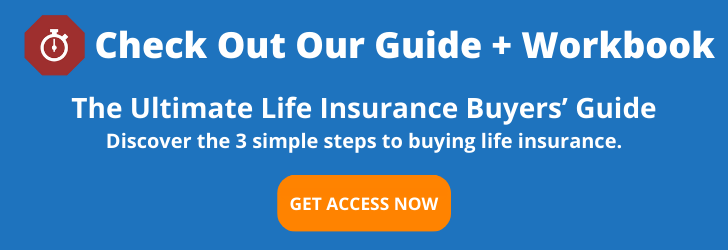09 Jun Indexed Universal Life Insurance Explained

An insurance agent is trying to convince you to buy indexed universal life insurance. But is it right for you?
Let’s get this out of the way first: Stop being sold financial products! Put yourself in the driver’s seat.
Yes, the different types of life insurance can be confusing. We get it.
According to Motley Fool, “11% of Americans say that the confusing nature of life insurance has driven them to avoid buying a policy.”
Just like other types of life insurance, indexed universal life insurance is not a one-size-fits-all product.
An oversimplified explanation of indexed universal life insurance is that it is a combination life insurance and investment product.
Sellers will emphasize that, with indexed universal life insurance, also referred to as an IUL, your dependents will receive a death benefit upon your passing, but you can also grow cash value at the same time that can be withdrawn whenever you want for whatever you want.
Unfortunately, some people think this combo life insurance-investment product will help them get rich quick.
This is not the case.
No one should purchase an IUL without fully understanding how it works or knowing if it is the right fit for his/her particular situation.
Today, we’re pulling back the curtain on indexed universal life insurance so you can make an informed decision about your financial future.
What Is Indexed Universal Life Insurance?
The easiest way to explain this type of insurance product is to break down the main terms in reverse.
First, there is life insurance.
Most of us know what life insurance is – a policy that guarantees your dependents will receive money upon your passing as long as you uphold your end of the contract (i.e., paying your premium payments).
Indexed universal life insurance (or IUL) is a type of permanent life insurance, which means it has a cash value component in addition to a traditional death benefit.
The second term to cover is universal.
When life insurance is universal, the policy has options that allow you to change the amount you pay for insurance, the amount of the death benefits, how much cash value you want, and more.
You are the one who chooses and changes the amounts.
The third term to cover is indexed.
In a standard universal life insurance policy, the cash account balance is guaranteed to grow at an interest rate based on either the current market or a minimum interest rate, whichever is higher.
With an indexed universal life insurance policy, the money in your cash value account can earn interest based on a stock market index, such as the S&P 500 or the Nasdaq.
You and your insurer choose the stock market index or indexes.
The cash account earns money based on the stock market value you choose. The funds don’t earn a fixed rate of interest but typically come with an interest rate guarantee.
Watch this video on Indexed Universal Life Explained.
How Does Indexed Universal Life Insurance Work?
When you make your IUL premium payments, a portion is taken out for the cost of the insurance (any fees or expenses that the insurance company charges). The rest goes toward a chosen index or indexes (like the Dow or S&P 500) that year for growth.
If the indexes are up in value in a given year, you will receive a positive gain in your cash value up to your cap or participation rates of the policy, minus any insurance expenses.
In good years, these types of policies have done really well.
But, it is very important to understand that the insurance company will always take out their expenses first.
So, if you have a not-so-great year and don’t see any gains in your cash value, the insurance company is still going to get their money.
If the indexes are negative, you will not suffer a loss of cash value, but (and this is a big but) the insurance charges will still come out.
If you don’t have any cash value left, you may have to increase your premiums to cover these costs or risk the policy lapsing.
If this happens, you’ll receive a notification from the insurance company that they need more money to cover fees, so your premium will go up.
What Are the Advantages of Indexed Universal Life Insurance?
Indexed universal life insurance offers flexibility, unlike traditional term life insurance.
Typically, you get a $250,000 policy and are told you’ll pay $30 a month for 30 years. There are no variables, and you don’t get to pick and choose.
In addition to the flexibility an IUL offers, the stock market investment is appealing.
You can take advantage of stock market returns without the risk of loss – that’s huge.
Plus, it does so while building up a death benefit that your beneficiaries will receive tax-free.
The Major Benefits of Indexed Universal Life Insurance (IUL)
There are several other benefits of indexed universal life insurance.
- Control over your death benefit and payments. You can increase or decrease payment amounts, depending on your need for coverage, the growth of your cash account, and your financial situation.
- Stock market index-driven rates of return on your cash value account. Your cash value can build up when the market grows, which is often accumulated tax-free. The index-based options can outperform fixed interest rates in other types of permanent policies, which gives you the potential to increase cash values faster while still limiting your downside risk. In a year when the market is down, you don’t lose money. You just get zero returns and pay insurance fees.
- Unlimited contributions. Unlike other tax-deferred accounts, such as IRAs, you do not have limits to the amounts you can put in your policy. For example, IRA contributions are maxed out at $6,000 in 2022 for those under 50.
- Tax-free growth and distributions. By using loan features to make withdrawals from your indexed universal life insurance policy, your distributions can be free of taxation.
- No age limit for withdrawals. Unlike other tax-deferred plans (IRAs), you have no age limit to withdraw your funds. As a result, you can withdraw money when you want to, for what you want to.
- Tax-free death benefit. Your death benefit is tax-free to your heirs. This includes the cash values that have built up inside the policy.
What Are The Disadvantages of Indexed Universal Life Insurance (IUL)?
Indexed universal life insurance is more complex than it may appear. It sounds too good to be true for a reason.
There is more risk involved with an IUL.
When an insurance company tries to sell an IUL, they will show you an illustration based on stock market projections.
Therefore, there is a risk that the stock market will not rise as quickly as the illustrations you were shown and led to believe.
We’ve seen some pretty outlandish projections – some even suggesting growth of 15%.
If you choose to purchase indexed universal life insurance based on illustrations like those, the return on your investment may fail to meet your goals. This may lead to you owing extra money to keep the policy from lapsing.
Indexed universal life insurance policies are complex.
They require work. You will have to work to maintain your cash value. It’s not a set-and-forget-it kind of policy.
You will need to go through illustrations yearly and make changes to your allocations based on these illustrations.
Indexed universal life insurance offers limited upside. You are capped on your returns based on the index caps and participation rates offered.
This means you don’t earn ALL the upside, but only the amount up to your caps.
These caps can also come down over time, which could further limit your cash value potential.
Additionally, the flexibility most are drawn to can come back to hurt you.
For example, the fees are also flexible, which means they can increase over time and eat into the payments you make or the value of your cash account.
Who Is Indexed Universal Life Insurance Good For?
It’s important to understand an IUL is an advanced, custom policy designed to fit an individual.
As such, an IUL is only a good choice for someone with a long-term goal.
If you don’t know how you’ll pay the premiums for a minimum of 10 years, this policy is not a good fit for you.
[Related Read: How Much Life Insurance Do I Need?]
There are some financial situations where an IUL policy may fit.
Here are two common examples:
#1 If you have maxed out all other contribution limits: Once you max out all the free matches of your 401(k) or workplace retirement plan AND max out your ROTH IRA contributions, you can put any remaining funds into an IUL.
#2 If you plan on helping fund your child’s education: You can use an IUL to accumulate unlimited amounts of cash value. The selling point here is that the cash value will not be included in assets when your child applies for financial aid.
Again, these scenarios describe situations where individuals have long-term goals.
If it doesn’t fit your financial goals, don’t allow yourself to be sold indexed universal life insurance.




No Comments